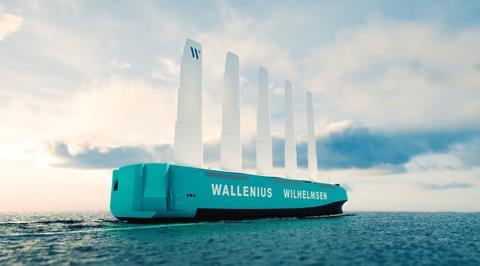Wallenius Wilhelmsen has presented Orcelle Wind, a concept for a primarily wind-powered pure car and truck carrier (PCTC) vessel that the finished vehicle logistics provider is confident could be on the water in 2025. In normal operation, it is expected to bring a 90% reduction in emissions.
The vessel will be 220m long and 40m wide, with a capacity of 7,000 vehicles, as well as some break bulk products, and is intended to sail at speeds of 10-12 knots when using only the sails, which can be collapsed in port or in adverse weather conditions.

There is a supplemental power system to increase that speed, or to provide propulsion when the wind is not sufficient. Wallenius Wilhelmsen has not yet settled on a technology for the supplemental propulsion system but it is considering various fuels including hydrogen, ammonia and green biofuels.
However, the standard service will not use the auxiliary power system and, at 10-12 knots, the Orcelle will be slower than what is common today. This may require a change in how automotive supply chains operate but so-called ‘slow steaming’ is gaining more acceptance as emissions requirements tighten.
Transit vs lead time
Chief customer officer, Xavier Leroi, explained that the sailing time needs to be put in the context of the lead time. When counting the dwell time in ports, the actual ocean transit time is relatively short, particularly when a lot of cars then sit in the port or a depot at arrival as stock.
He added: “We can reduce the number of ports [and] we can look at different rotations to mitigate the longer sailing time, but all in all I think this is again about engaging with our customers and discussing this concept of ’hurry up and wait’, where basically all units are rushed to destination, where most of them sit there and wait.”
The wind-powered vessels may be integrated into Wallenius Wilhelmsen’s overall network, or operated as a standalone service on key routes where wind conditions are favourable. A fixed loop for the North Atlantic, but with flexibility to cover additional ports and routes is likely to be the first test case, as the environmental regulations in this region would make the more environmental solution more desirable, despite the likely higher cost.
Although the design has yet to be finalised, with the final cost still unclear, CEO Craig Jasienski said that the expectation is that it will come at a premium. “Any innovation of this degree is going to cost more and that’s a commitment that I think we need to be willing to make. We certainly believe the market will be willing and ready to accept,” he added.
He told Automotive Logistics that despite the strong interest from car manufacturers in sustainability, it is a ‘fourth dimension’ that is still often missing from the supply chain, with cost, quality and speed remaining the main drivers.
Although there is clear movement, there is still a need for more alignment within the industry, as Jasienski illustrated: “We have had some paradoxical situations where we had some manufacturers who requested us to speed a certain shipment of product to a destination, where we’ve transparently and knowingly explained to them what the increased carbon impact would be through that decision, but yet we’ve still been requested to execute that. So, we did that, but the next day we’re asked the question what we are doing to improve sustainability in the supply chain.”
The company intends to have blueprints for yards ready by 2022, for a potential launch in 2025. WW is still finalising designs and securing funding, but is confident that the concept will become a reality. However, the company says that it will be dependent on partnerships with customers and whether there is commitment in the market to adopt radical and innovative measures to drastically reduce the environmental footprint of outbound supply chains.







































No comments yet